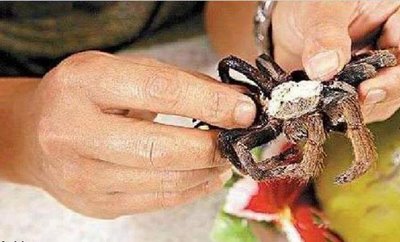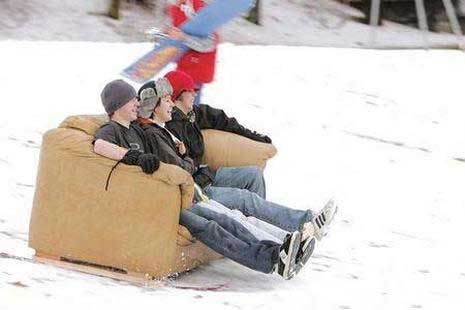Personal Safety
Most of staying out of harm’s way comes down to using common sense: Lock
your house and car, know who to call when you need help, and be prepared for
emergencies. Easier said than done! We often postpone doing what we know we
should, or let common-sense safety precautions slide entirely, in the haste
and distractions of daily life. These lists will tell you what you need to
do and what you should have on hand to prevent—or deal with—emergencies, so
you can be calm and efficient when it really matters.
How to Avoid Being a Victim
Next to common sense, your best personal safety tool just might be your
“uncommon sense,” your intuition. Take yourself seriously if you sense
danger or have a bad feeling about a person or situation. Do not be
embarrassed or afraid to offend: Get away immediately. The National Crime
Prevention Council suggests these ways to keep yourself safe wherever you
are.
AT HOME
1. Don’t hide house keys in planters, mailboxes, under doormats, or in other
common (and obvious) places.
2. Don’t put your name or address on your keys. Losing them irretrievably is
much better than giving a criminal the key to your house and car.
3. Don’t open the front door without finding out who it is. Verify the
identification of service personnel, even if you are expecting them.
4. Don’t rely on door chains. They can easily be kicked in or otherwise
broken.
5. Never give personal information to unknown or “wrong number” callers.
This includes your phone number, social security number, credit card number,
and address.
6. Don’t reply to harassing phone calls. Hang up immediately.
IN PUBLIC
1. Stay alert to your surroundings. Take note of who is behind and ahead of
you. Use your peripheral vision to keep track of anyone gaining on you.
2. Get away. Don’t second-guess your instincts just to avoid embarrassment
or give someone the benefit of the doubt. If you think you’re being followed
cross the street if possible and go to a well-lit place where there are
other people.
3. Carry a shrill whistle and don’t be embarrassed to use it if you suspect
you may be in danger.
4. Always walk as if you know exactly where you are going. Stand up straight
and make brief, self-confident eye contact with people around you. Police
believe that rapists and muggers target victims who appear vulnerable, weak,
easily intimidated, or who seem to be daydreaming. Conduct yourself
accordingly!
5. Hold on to your valuables. Women should carry their purses close to the
body. Men should carry wallets in inside coat pockets, not pants pockets.
6. Don’t look like an easy target. Avoid carrying large amounts of money and
wearing obviously expensive jewelry. Handle your money and credit cards
carefully; try not to display them while making transactions.
7. Plan the safest route when walking—day or night. Avoid alleys, vacant
lots, deserted streets, and construction sites.
8. Lighten your load. Avoid walking with a large load of packages or grocery
bags. They slow you down and make it difficult to react quickly.
9. On public transportation:
• Avoid sitting near doors and exits. You are more vulnerable to being
robbed or attacked by a criminal on foot.
• Be aware of who gets off a bus or train with you. If you think you’re
being followed, walk directly to an area with other people and good lighting
10. In an elevator:
• Take a quick look before getting in an elevator. If someone suspicious is
on board, or gets on with you, back out and wait for another car.
• Stand near the elevator controls.
• If you are attacked, hit the alarm and as many floor buttons as possible.
IN THE CAR
1. Lock your door and keep the windows rolled up. Always lock the doors when
you park your car, no matter where you are or how brief a time you’ll be
away.
2. Look around. Check the front and back seats and floors of your car before
getting in.
3. Keep your car well maintained and the gas tank at least half full. This
will lessen the chance of your being vulnerable on the highway.
4. If your car does break down, put up the hood and lock your doors and
windows. Set out flares if you have them and use your cell phone to call for
assistance. If a stranger stops to help and you don’t have a phone with you,
roll the window down an inch or so and ask him to call police or a tow truck
(See chapter 18, “What to Carry in Your Car”).
5. Don’t drive home if you’re being followed. Go to a police station or a
well-lit service station where you can use the phone. Never get out of your
car unless you’re positive you can get inside safely.
6. Don’t pull over if someone tries to force you off the road. Get a
description of the vehicle and write down the license number. Drive
immediately to a police station or any open business and report the incident
to the police.
7. Don’t stop if a passing motorist indicates something is wrong with your
vehicle. Drive to a well-lit area with people around before stopping to
check your car.
8. Don’t stop in an isolated area to help someone who appears to have a
disabled vehicle. Drive to a phone and call for help instead.
9. Don’t stop for flashing headlights or another signal from another car
unless you see the blue or red lights of a police vehicle.
10. Put your purse on the floor of the car while you’re driving. Leaving it
conspicuously on the passenger seat could tempt a thief to break in and grab
it.
11. Never pick up hitchhikers. Need it be said?
IF YOU ARE ATTACKED
1. Staying calm is your best defense because you’ll be better able to judge
the situation and consider your options.
2. If the attacker is unarmed—and if you sense you could get away—fight back
But not getting injured is your first priority. If the attacker has a
weapon, don’t take the risk of resisting.
3. If your life is threatened, do anything you can to hurt your attacker and
get away. Concentrate your attack at the eyes and groin. If you’re holding
your keys, jam them right into the eyes if you can. Don’t wait to check the
effect, run away as fast as you can.
4. You may be able to avert an attack by behaving bizarrely. Experts suggest
acting crazy, picking your nose, throwing up—whatever comes into your head.
If Your Wallet Is Stolen . . .
When your wallet is stolen, you have two major issues to deal with. They are
(to paraphrase the old Jack Benny joke) your money and your life. A thief
with your driver’s license and credit cards can use the contents of your
wallet to obtain a new set of identification documents in your name—making
your funds and your credit line completely accessible. Following the steps
in this checklist will help ensure that your identity as well as your money
and credit are protected.
1. Report the crime to the police right away and get a copy of the police
report. You may be asked for it later by your credit card companies, your
insurance company, your bank, or other agencies to verify the crime.
2. Call each credit card company to report the theft right away. If you’re
away from home, ask a family member, neighbor, or house sitter to pull your
master list of credit card numbers and other relevant information from your
files to make sure you cancel every card. (See chapter 2, “Records and
Documents You Need at Home.”)
3. Report the theft to the three major credit reporting agencies, Experian
(formerly TRW), 800-682-7654; Trans Union, 800-916-8800; Equifax,
800-685-1111. This alerts them to halt any credit checks that could be the
result of a thief shopping in your name.
4. If your checkbook or ATM card was taken, call your bank immediately and
stop payment on outstanding checks that don’t sound familiar. Request new
bank accounts, a new ATM card, and a new PIN.
5. If you have a safe deposit box at the bank, call that department to
report the theft.
6. Notify the passport office to watch for anyone using your identification
to obtain a fraudulent passport.
7. Inform your local and long distance telephone carriers and your utility
companies that someone might try to open service in your name.
8. If your keys have also been stolen, change all the locks on your home and
car.
9. After the theft:
• Monitor your credit card and bank statements carefully for charges that
occurred after the theft and that might have slipped past officials at these
agencies.
• Order your credit report from all three agencies (Experian, Trans Union,
Equifax) at least quarterly, to catch possible fraudulent use of your credit
Important Numbers to Keep by Your Phone
Look up the numbers below before you need them (most emergency numbers are
on the first page of your local phone book) and keep them near your home
telephone. To make sure emergency numbers are easy to find when you need
them, laminate a list and attach it to the refrigerator, or tape it inside a
cabinet door near the phone. Include important information that anyone
calling from your home would need to report in an emergency, such as your
street address and phone number.
EMERGENCY PHONE NUMBERS
1. 911. This number should only be used when you need immediate assistance
from the police, the fire department, or an ambulance. If you’re tempted to
use it for less serious reasons, imagine getting a 911 busy signal if you or
a family member needed immediate help. Teach your children how to dial 911
and make sure they know how to give their home address.
2. Police emergency. Most cities have a number to call other than 911 for
situations that are urgent, but non-life-threatening, such as traffic
accidents.
3. Police nonemergency. This number is for occasions when you want to report
stolen or vandalized property or any matter that requires a police report,
but doesn’t require immediate response.
4. Work telephone and cell phone. Even if your children have these numbers
memorized, it’s a good idea to have them posted in case they forget, or if
anyone else needs to reach you in an emergency.
5. Fire department. In case of fire, call 911. When neither life nor
property is immediately threatened—if you smell something burning, but can’t
confirm a fire—use the nonemergency number.
6. Poison control center.
7. Doctor and pediatrician.
8. Dentist.
9. Veterinarian.
10. Emergency vet information. The University of Illinois at
Champagne-Urbana offers twenty-four-hour poison control help for animals for
a $30 fee at 800-548-2423. Ask your own veterinarian what other emergency
numbers you should have on hand, including the nearest twenty-four-hour
emergency clinic for off-hour emergencies. (Make sure you know where the
clinic is, and how to get there.)
FREQUENTLY CALLED NUMBERS
1. Electrician.
2. Plumber.
3. Neighbor. List at least one who would be available to come over if needed
You may know your neighbor’s number by heart, but post it next to the phone
for anyone else who might need assistance while in your home.
4. Newspaper circulation department, to report missed papers or to suspend
delivery during vacations.
5. Pharmacy. Your pharmacist is a good person to call for questions about
side effects and interactions of over-the-counter and prescription drugs.
6. Children’s schools, for reporting absence, tardiness, and so forth. Also
keep numbers for coaches, tutors, and music instructors where you can find
them.
7. Hair salon and barber.
8. Auto mechanic.
9. Auto insurance agent. Put your policy number right next to the phone
number.
10. Housekeeper.
11. Home maintenance. Keep numbers for any services you regularly receive,
such as gardeners or pool cleaners.
12. Restaurants, including take-out places for delivery, and favorite eat-in
restaurants for making quick reservations.
13. Movie theaters.
14. Baby-sitters.
15. Pet sitters and dog walkers.
16. Florist.
17. Train information.
18. Bus information.
19. Taxi services.
20. Airlines. List your frequent flyer numbers next to the airline’s phone
number.
21. Bank. Keep your account numbers next to the phone numbers.
Everyday Burglar-Proofing for Your Home
There’s no foolproof way to foil a clever or determined burglar. But there
are several things you can do to protect your home from a crook who’s
looking for an easy mark. According to the National Crime Prevention Council
half of all burglaries occur because residents have neglected to lock doors
and windows—proof that minimal security can make a big difference. Take
these easy steps to secure your home.
1. Lock doors and windows before leaving the house. Make it a habit to check
them at night.
2. Get pick-proof locks for all your windows.
3. Install dead bolts on your front and back doors. Anything else can be
more easily broken.
4. Put a dowel or broom handle in the track of sliding-glass doors so they
can’t be opened even if the lock is tampered with.
5. If there’s a pane of glass within easy reach of an inside door lock,
consider getting a lock that only opens from inside with a key.
6. Plant prickly or very thick shrubs and plants under your windows to
create a physical barrier.
7. Install motion detector lights outside, especially in back or side yards
where burglars like to hide.
8. If you’ve been thinking of installing window bars or a home alarm system,
don’t put it off. If you don’t have a security alarm system it can’t hurt to
place stickers in your windows indicating that you do. As always, the idea
is to deter a burglar looking for an easy mark.
9. Keep expensive equipment and other valuables away from windows where they
can easily be spotted from outside.
10. Join or start a neighborhood watch group. Neighbor-to-neighbor networks
are one of the most effective ways to discourage crime.
Securing Your Home While You’re Away
In addition to the burglar-proofing tips above, take the following
precautions whenever you’re going to be away for an extended time. You can
discourage intruders by creating the impression that someone is in the house
or will return shortly.
1. Keep drapes and shades as you normally have them. Don’t make the mistake
of giving your house that “closed for the season” look with every window
shuttered.
2. Hire a house sitter or have a neighbor come in to turn on lights and open
and close drapes.
3. Stop your newspaper delivery and have your mail held at the post office.
Piles of papers are a sure sign that no one is home.
4. Set a few timers and set them to turn lights on and off at different
times in different parts of the house, echoing your typical patterns.
5. Leave a car parked out front or in the driveway. Or invite a neighbor to
park there every day or so. If you live in a snowy area, arrange for someone
to shovel your walk and driveway, or even just to drive in and out of your
driveway when it snows to create the impression that someone is home.
6. Adjust your answering machine message if necessary. You may want to tell
callers that you’ll “be back shortly” so scammers don’t hear an invitation
to an empty house.
7. Put away large trash cans, outdoor furniture, or anything else that could
provide climbing assistance to intruders.
8. Consider buying a safe. If you don’t have a safe, you may want to hide
small items like jewelry or cash in unlikely places (see below for
suggestions).
9. Leave the radio or TV on. It can’t hurt.
Best and Worst Places to Hide Valuables
Since you can’t guarantee an intruder won’t get into your home, it’s
important to think strategically about hiding valuable items inside. Indoors
your best defense is a good offense: make the burglar’s job as difficult as
possible.
THE WORST PLACES TO HIDE VALUABLES
1. Jewelry boxes. If you use a traditional jewelry box, hide it. Consider
storing jewels in less obvious containers (see below).
2. Dresser tops and accessible drawers. Don’t keep cash or jewelry on
dressers, in sock or underwear drawers, or in any drawer that’s in easy
reach and can be rummaged through quickly.
3. Under the mattress or beside the bed. Many burglars look in these places
first, especially when they’re checking for weapons.
THE BEST PLACES TO HIDE VALUABLES
1. Your closet may be a good spot to tuck your jewelry box.
2. A sewing kit or tackle box can harbor cash or items of jewelry without
offering temptation to a burglar.
3. Clever decoys are among the best places to hide and disguise your
valuables. False wall outlets don’t provide electricity, but they do provide
a good hiding place (you can plug cords into these or put furniture in front
to make them more realistic and less obvious). Fake food or cleaning product
cans and hollow books are also widely available.
4. The bathroom is bypassed by most burglars, unless they’re looking for
prescription drugs. Avoid the medicine cabinet, but stash items in other
bathroom cupboards, especially among cleaning supplies.
5. Kitchens offer hiding places where burglars may not look. Consider
wrapping jewelry or cash in foil and storing it in the freezer.
6. Basements are good places for valuables because burglars don’t want to
take the time and trouble required to rummage through them.
Many cities have stores known as “Cop Shops” which sell burglar-foiling
devices. Call your local police department for information on your nearest
store.
Common Home Accidents and How to Avoid Them
No matter what kind of work you do, or how good it feels to come home after
a rough day at the office, safety statistics suggest you’d be better off
staying at work. More people in this country die from accidents at home than
at work—five times as many! More people are disabled in home accidents than
in work injuries and car crashes combined. National Safety Council president
Jerry Scannell stresses that all home accidents are preventable. Here are
the most common home accidents and the NSC’s recommendations for preventing
them.
1. Falls.
• Fasten carpet edges securely and put nonslip mats under area rugs.
• Keep telephone and electrical cords where they can’t be tripped over.
• Put away toys, clean up clutter, and move obstacles out of walkways.
• Wipe up all spills immediately.
• Use nonskid tub and shower mats and install grab bars in toilet and bath
areas.
• Equip all indoor and outdoor staircases with securely fastened handrails
along both sides. When it snows, use salt or cat litter on sidewalks and
driveways to prevent slipping.
2. Poisoning. More than one million children under age five are accidentally
poisoned every year.
• Lock drugs, household cleaners, and other potentially hazardous
substances where children can’t get to them.
• Don’t leave children unattended in a garage, bathroom, kitchen, or any
place where potential poisons are kept.
• Never store household cleaners in unmarked containers where they might be
mistaken for something safe to drink.
3. Fire. Smoke detectors reduce the chance of fire fatalities by 40 to 50
percent, according to the National Fire Protection Association.
• Install a smoke detector in each bedroom and at least one on every floor
of your home.
• Make sure your family is well drilled in an escape plan, including two
ways to exit every room. Practice regularly so everyone learns to respond
automatically and without panic.
4. Electrical shocks. Ground-fault circuit interrupters (GFCI) are
electrical outlets with quick-tripping circuit breakers that instantly shut
off power if an appliance plugged into them overheats or comes in contact
with water. They are now required in all new construction and remodeling
jobs in bathrooms, kitchens, laundries—wherever shock hazards are greatest.
If your home doesn’t have these life-saving electrical outlets, consider
having them installed by an electrician.
BE PREPARED FOR EMERGENCIES
If an accident does occur, or if a family member becomes ill suddenly,
knowing what to do immediately can make the difference between life and
death. Have each member of the family take age-appropriate first aid and CPR
classes. Post a list of emergency numbers next to the telephone (see chapter
1). Put together a survival kit in case of disasters (see chapter 1).
Remember that seconds count in a fire.
Top Twenty Safety Items for Your Home
Here are the top twenty home-safety items recommended by the National Safety
Council. Every item you have on hand decreases the risk that someone in your
home will die or be injured in a preventable accident.
1. Smoke detectors. Change the batteries twice a year when you change your
clocks. The National Fire Protection Agency (NFPA) recommends that you
replace your smoke detectors after ten years and test them once a month to
be sure they work.
2. Carbon monoxide detectors. The NFPA recommends these alarms for
households with attached garages and those with fuel-burning appliances or
fireplaces.
3. Ground-fault circuit interrupters. These electrical outlets with
quick-tripping circuit breakers help prevent death or injury from
electrocution and can be installed by an electrician. (See chapter 1 for
more detail on how they work.)
4. Fire extinguishers. A multipurpose dry chemical class ABC type is the
best fire extinguisher for home use. Keep one in the kitchen, one in the
bedroom, one near the fireplace, and one in your car. Make sure everyone in
the household knows how to use them. Check the extinguishers periodically
and replace them when they expire.
5. Emergency evacuation plan. Come up with a plan for escaping in a fire and
for natural disasters. Make sure everyone in the house participates in the
practices.
6. Flashlights. Keep a flashlight under or near each person’s bed and one in
the basement. If you live in an area with frequent power failures, buy a few
of the kind with a large base so they don’t have to be hand held if the
power is off for several hours. Check batteries every few months and store a
supply of extra batteries where you can find them easily.
7. First aid kit. See chapter 1.
8. List of emergency phone numbers. See chapter 1.
9. Shutoff valve tags. Label the turnoff valves for gas, oil, and water and
clearly mark the main electricity shutoff. Know how to use each in case of
emergency.
10. Grab bars. Since falls are among the leading causes of home accidents,
and bathtubs are among the slipperiest surfaces, anchor grab bars into the
wall studs in tubs and showers.
11. Slip-resistant finishes. Use nonslip mats or strips or decals in
bathtubs and showers to help prevent slipping.
12. Safety glazing. Every glass pane in your house should be shatterproof.
Look for a mark in the lower corner showing the manufacturer’s name and type
and thickness of safety glass. Don’t forget shower and patio doors.
13. Handrails. Indoors or outdoors, every staircase in your home should have
secure handrails on both sides.
14. Step stool/utility ladder. Keeping a lightweight, sturdy step stool in
an convenient spot will decrease the likelihood of anyone taking chances
standing on a chair or other dangerous perch.
15. Sufficient lighting. Help prevent falls with nightlights near bedrooms
and bathrooms. Keep interior and exterior stairways and walkways adequately
lit.
16. Tested appliances. Every electric and gas appliance in your home should
carry the Underwriters Laboratories (UL), Canadian Standards Association
(CSA), or American Gas Association (AGA) designation.
17. Safety goggles. These are an absolute necessity when using certain tools
they’re also recommended by the NSC for indoor cleaning and garage and yard
work.
18. Survival kit. See chapter 1 for details on what to include.
19. Childproofing. See chapter 10 for information on how to childproof your
home.
20. Pool safety. Homes with swimming pools should have the following:
• A four-foot fence with self-closing and latching gate
• Life preservers
• Rescue equipment
• Lockable cabinet for storing pool chemicals
• Poolside telephone
What to Keep in Your Medicine Cabinet
When you’re stocking your medicine cabinet, think about common illnesses and
discomforts. First shop for those and then add any other over-the-counter
medications required by members of your family. If you stock up on the items
on this checklist, you’ll be prepared to cope with a wide range of minor
maladies. It’s also a good idea to check with your doctor and your
pharmacist for other medicine cabinet suggestions.
1. A fever reducer and pain reliever such as Tylenol or other aspirin
substitutes containing acetaminophen. Many medical experts recommend taking
nonaspirin remedies for fever and pain because they’re less likely to
irritate or upset the stomach.
2. Ibuprofen. An anti-inflammatory used to reduce pain and swelling. It
should be given only to adults because its use has not been proved safe in
young children. Advil and Motrin are common brands.
3. Aspirin. It is wise to keep aspirin on hand in case someone in the house
has a heart attack. Aspirin is a blood thinner and chewing one while dialing
911 could save a life. Aspirin should never be given to children or
teenagers because its use by young people has been associated with Reye’s
syndrome, a rare but sometimes fatal condition.
4. Antibiotic ointment for cuts, scrapes, or burns.
5. Hydrocortisone cream for rashes and other skin irritations.
6. Hydrogen peroxide for cleaning wounds and disinfecting minor cuts.
7. Antihistamine (for colds, allergies, itching). Benadryl is the most
commonly known name in antihistamines.
8. Decongestants and cough remedies (suppressants and expectorants) for cold
symptoms.
9. Soothing lozenges for sore throats.
10. Antacids.
11. Antidiarrhea medication.
12. Band-Aids.
13. Tweezers. (Keep matches nearby to disinfect before using on splinters,
ticks, etc.)
14. Thermometer.
15. Cotton balls and swabs for applying medication.
What to Keep in a First Aid Kit
Every family should have at least two well-stocked first aid kits. Keep one
in your car and one at home, in a spot where you can get to it easily but
small children cannot. (And don’t forget to take the first aid kit when your
family goes away on vacation.) Check your kits every few months and replace
any missing items or expired medications. Buying a preassembled first aid
kit can be a convenient starting point, if you add any items that are on
this checklist but not in the kit. Items that overlap with the contents of
your medicine cabinet need only be kept in your car kit.
1. First-aid manual.
2. Sterile gauze pads (4×4 and 2×2 size) and rolls of gauze for wrapping.
3. Adhesive tape.
4. Adhesive bandages in various sizes.
5. Scissors.
6. Elastic bandage (Ace, for example).
7. Safety pins for making slings (you can use a towel, diaper, or other
cloth for an emergency sling).
8. Latex or thin plastic medical gloves.
9. Peroxide for cleansing wounds and dissolving blood stains.
10. Antiseptic liquid or ointment (Betadine, polysporin, etc.) and
antiseptic wipes (these might be best for an automobile kit).
11. Small plastic bags to make ice packs (keep ice on hand in the freezer;
or a bag of frozen vegetables will work as an ice pack in a pinch.)
12. Benzocaine spray for minor burns and abrasions.
13. Hydrocortisone cream for minor inflammatory skin conditions (get a
doctor’s diagnosis if condition lasts more than twenty-four to forty-eight
hours).
14. Benadryl or other antihistamine tablet to relieve itching.
15. Ibuprofen. Many doctors now prefer it to aspirin or Tylenol for fever
and recommend ibuprofen for children under twelve, who should avoid aspirin.
16. Saline eye drops. Keep a large bottle to flush chemicals or foreign
matter from eyes.
17. Tweezers. (Keep rubbing alcohol or matches nearby to disinfect them
before use.)
18. Thermometer.
19. Mouthpiece for administering CPR. These can be purchased from your local
Red Cross chapter. They range in price (and sophistication of design) from
$2 to $12. They are sometimes given free to those who take rescue breathing
(CPR) classes.
20. Cotton swabs for applying ointment or cleaning small areas.
If you plan to keep syrup of ipecac on hand to induce vomiting in cases of
accidental poisoning, talk to your doctor, who can advise you when not to
use it. In certain situations, such as loss of consciousness or ingestion of
caustic substances, it can be dangerous. Never administer ipecac until
you’ve called your poison control center and discussed the situation with an
expert.
What to Keep in a Disaster Kit
The secret to coping as calmly as possible with an emergency is to be ready
before it happens. Earthquakes, hurricanes, blizzards, and other natural
disasters are unnerving enough. When they cut off access to power, water,
groceries, and other necessities, they can be both frightening and
disorienting. But if you’ve stockpiled essentials ahead of time and coached
your family on disaster preparedness, you will have as much protection as
you can.
A 30-gallon trash can, a large plastic storage bin, or any other durable,
reasonably light container with a tight-fitting lid will make a fine
disaster kit. Store the kit in a garage, basement, or any out-of-the-way
place that is large enough to accommodate it and reasonably easy to get to.
(You won’t want to climb into the attic in some types of emergencies.)
1. Tools. Pipe and crescent wrenches, screwdriver, crowbar, and any tools
required to turn off utilities if necessary. Ask your utility companies how
to turn off gas, water, and electricity in an emergency. Don’t turn off the
gas unless you’re certain there is a leak. You may have to wait days to have
it restarted by the gas company.
2. Heavy protective gloves.
3. Candles and matches. Keep them in a watertight container within the kit.
4. Battery-operated radio.
5. Flashlight.
6. Extra batteries for radio and flashlight.
7. Fire extinguisher.
8. “Swiss Army” knife.
9. Can opener.
10. Eating utensils.
11. Disposable plates (paper, Styrofoam, or plastic).
12. Aluminum foil.
13. Plastic trash bags.
14. Extra blankets. You can buy emergency foil blankets (which store very
compactly) at camping or sporting goods stores.
15. First-aid kit (see chapter 1).
16. Personal items. Pack toothbrushes, toothpaste, razor, combs, soap, and
other items your family will want for personal hygiene.
17. Warm clothes and sturdy shoes. The shoes can be especially important if
floors are covered with broken glass. A heavy sweater for each family member
will come in handy if your home is without heat. If you live in an
earthquake zone, keep your sturdy shoes under the bed in case a quake hits
at night. If you need to be prepared for a severe weather disaster or an
evacuation, store the shoes and warm clothes near the top of the kit where
they’ll be easy to get to.
18. Money. Hide enough cash to get your family by for at least three days.
See chapter 1 for “Best and Worst Places to Hide Valuables.”
19. Nonperishable food. Store enough prepared food that doesn’t need heating
to feed your family for at least three days. It’s a good idea to choose
foods your family enjoys (and to include candy bars and other treats) to
keep morale and energy up. To keep your emergency stash fresh, rotate the
food (including canned goods) into your pantry at least every year and
substitute with newly purchased items.
20. Bottled drinking water. One gallon per person, per day for at least
three days is the rule of thumb. Store water in airtight containers and keep
the jugs away from gasoline or other products with poisonous fumes. Replace
the stored water twice a year (changing the water when you turn your clocks
for daylight savings will help you remember to do it) and use the old water
to drench the garden.
21. Bleach or disinfectant tablets. If water has been contaminated with
bacteria, you can purify it by adding a teaspoon of bleach per gallon of
water or disinfectant tablets according to the manufacturer’s directions.
BE PREPARED
•To prepare for a possible evacuation, put important family documents
together in a small plastic container and know the location of the mementos
and heirlooms you would grab if authorities ordered you to leave immediately
•Keep your vehicle’s gas tank at least half full at all times and fill it up
at the first mention of possible severe weather.
•To prepare for any disaster, designate an out-of-state relative or friend
to be called in case the household gets separated. That way, each person
will know the others are accounted for, even if they can’t get in touch with
them right away.






















